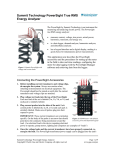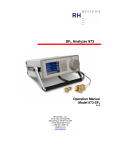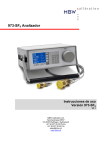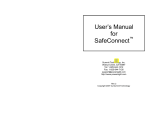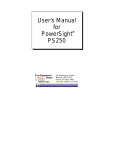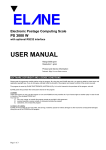Download Getting Started Manual for Serial Meters
Transcript
Getting Started With PowerSight For Serial Meters Summit Technology, Inc. Walnut Creek, CA 94597 Tel: 1-925-944-1212 Fax: 1-925-944-7126 [email protected] www.powersight.com Rev for All Meters / SW 3.4 Series Copyright 2011 by Summit Technology 1 PowerSight is a registered trademark of Summit Technology, Inc. All PowerSight models are designed to comply with part 15, subpart B, of the FCC Rules for a Class A digital device. PowerSight models PS250, PS3000, and PS4000 are designed to comply with the requirements of ENC61010 for a 600V input rating measurement category II, pollution degree II, double insulated electronic device. PowerSight meters are manufactured by Summit Technology, Inc in the U.S.A. The standard warranty period is 12 months from date of purchase. We encourage you to advise us of any defects of design or manufacture of any of our products. We are dedicated to your successful use of the product. There are no user serviceable parts in your PowerSight meter. Opening the case voids your warranty and may result in present or future danger to users of the meter. The rechargeable battery inside is a custom-designed battery pack that is only to be replaced by authorized Summit Technology technical service personnel. Cleaning is to be done by use of a dry or damp piece of cloth. Grease may be removed by light application of isopropyl (rubbing) alcohol. Avoid the use of solvents, since they may dissolve or weaken the plastic enclosure. Do not use water or other conductive liquids since they may pose a safety risk. Use of this equipment in a manner not specified by Summit Technology can result in injury and voiding of warranty. 2 Table of Contents Introducing PowerSight .............................................................. 4 Installing PSM Software .............................................................. 5 System Requirements ........................................................................... 5 Installing and Running PowerSight Manager (PSM) ............................. 5 Installing USB-RS232 Adapters .................................................. 6 Software Installation Instructions ........................................................... 6 Upgrading Software/Firmware Via PSM .................................... 8 Connecting to PSM for the First Time ..................................... 10 Connecting Via Serial Port .................................................................. 10 Software and Meter Interface.................................................... 12 PSM Interface ...................................................................................... 12 Meter Interface .................................................................................... 13 Setting up PowerSight for Logging ......................................... 14 Using PSM to Setup PS250 & PS3000 Meters ................................... 14 Using PSM to Setup PS4000 Meters .................................................. 16 Using PowerSight Interface to Setup Meter ........................................ 19 Hooking Up Your PowerSight................................................... 20 Connections to PowerSight ................................................................. 20 Verifying Connections............................................................... 20 Using SureStartTM of PowerSight (PS250) .......................................... 21 Using Checkout Connections of PowerSight (PS3000 & PS4000) ..... 22 Checking Out Connections Using PSM............................................... 22 Checking Voltage/Current Levels – Using PSM .................................. 23 Starting/Stopping Your Monitoring Session ........................... 24 Downloading Data Using PSM .................................................. 24 Downloading Data Via Serial Connection ........................................... 24 Creating A Report Using PSM .................................................. 26 3 Introducing PowerSight Congratulations on your decision to buy one of our PowerSight meters! You have just purchased one of the smallest and yet most powerful instruments for measuring and analyzing electric power that exists. Each PowerSight meter is uniquely designed to help answer your power analysis questions like; what does it cost to run this equipment, to, what sort of transients appear on this line? The philosophy of the product is to give you an instrument that answers your questions about electric power in a truly convenient size at an attractive price. If you are looking for a simple yet powerful tool that can be easily and reliably installed and operated, one that provides for comprehensive data analysis, you've found your tool of first choice. Whether your interest is in The quality of incoming power, Managing power consumption, or Maintaining and comparing equipment PowerSight puts all the power in the palm of your hand! This guide will show you all the basics of using your PowerSight meter, from installing our simple-to-use PSM software, to hooking up your meter for the first time. *Note: Throughout this manual, whenever we refer to an individual key of the keypad, we print the name on the key enclosed by square brackets. For example, the “Volt” key is referred to as [Volt]. 4 Installing PSM Software System Requirements PowerSight Manager is a powerful program that is designed to operate on modest systems. However, having certain system resources will dramatically improve its performance. Following is a list of capabilities required in your PC system in order to run the PSM 3.4 Series and newer software: Operating system: Windows ® XP or newer (when using Windows XP, system must be updated to the latest service pack and have Microsoft .NET installed). Disk Drives: CD-ROM disk drive (for installation) and a hard disk with at least 20 MB free. Serial Communications: Either an RS-232 serial connection for models PS250, PS3000 & PS4000, or a USB connection for use with a USB-to-RS-232 adapter (see USB adapter compatibility). Display: VGA or better capability. Installing and Running PowerSight Manager (PSM) The CD-ROM that accompanies this guide contains all the files required to begin using PowerSight Manager. Following installation, refer to the Help system within it for answers to all your questions. Assuming that your CD-ROM is defined as drive D: and your hard disk is defined as drive C:, perform the following steps to install PSM: 1. Insert CD-ROM disk into drive D: 2. The software installation window should now automatically run on your computer. If it doesn’t start, follow steps 3-5. 3. Click on the "Start" button at the lower left of the screen 4. Select "Run" from the list of options. 5. In the "Open" box, type in “D:\autorun”, then press the “Enter” key. 6. Click “Install PSM Software” to begin installing the application. 7. Follow any instructions that appear on the screen. For easy installation, click on the “Next” button each time it stops to ask a question and click on “Finish” at the end. To run PowerSight Manager in the future, select “Start” then guide your mouse from “Programs” to “PowerSight” to “PowerSight Manager” and click on “PowerSight Manager”. 5 You can also double click on the PowerSight manager icon that is loaded on your desktop. Remember, the software on the disk is only licensed for use with your PowerSight meters. Installing USB-RS232 Adapters You can communicate with your PowerSight PS250, PS3000, or PS4000 meter using a USB port of your computer by using our USB-RS232 adapter. This offers a convenience for some users and it is a necessity for others who do not have an RS-232 serial port on their computer. For this example, the adapter being used is a Keyspan USB adapter. Other compatible brands are Dynex and IO Gear. Software Installation Instructions 1. Insert CD-ROM and the adapter software should start. 2. Click on “Install Software”. 6 3. Click the button for your operating system (for Windows 7, click on the Vista button”). 4. Click “Next” on the install screen, accept the License Agreement, then click “Next” again to start the installation. 5. Either choose to register the Keyspan device or click “Cancel”. 6. Clicking on “Finish” completed the installation. 7. Plug in the Keyspan USB-RS232 adapter to an available USB port. 8. There should be a pop-up window that appears telling you what COMM port was created by the adapter. Write this down as you will need it later. 9. If the pop-up does not show up, you can go to C:\Program Files\Keyspan\USB Serial Adapter and double click on K19HAsst.exe to run the Keyspan program. 7 10. Click on the “Port Mapping” tab to see what comm port the Keyspan has created. You can also change this port from this tab. Upgrading Software/Firmware Via PSM PSM version 3.48 and newer supports upgrading to the latest eligible version of PSM via the web. By default, PSM is set to check for software updates every time it is opened while the computer is connected to the internet. For PS4000 meters, it also checks if there is a newer firmware upgrade available each time the meter is connected. You can change how often automatic updates occur (or to disable them) by going to TOOLS->Check for Software/Firmware Updates. 8 If an update is available, a pop-up should appear, showing what version is available. Press “Install” to upgrade. NOTE: Do not upgrade Firmware unless you have downloaded all data and data setups needed from the meter as the meter will erase this data after upgrade. To manually upgrade the meter (PS4000 only): 1. download the firmware file for your meter at http://www.powersight.com/downloads/index.cfm?list=Fir mware. 2. In PSM, connect to the meter and click on TOOLS->Firmware Upgrade. 3. Once the Firmware upgrade window pops up, press “Browse” and find the desired PSXXXX-XXX.s19 file, 9 press open, then press “Upgrade”. NOTE: Upgrade time may take several minutes. Connecting to PSM for the First Time Connecting Via Serial Port Connect to your PC via either the RS-232 serial port, or thru a USB-RS232 adapter. 1. Determine what Comm port your serial port/adapter is on. If it is an RS-232 port on the computer, it is either Comm1 or Comm2. If using the adapter, this should be told to you when installing. 2. Open up PSM and press the “Setup Communications” button. 3. Select the correct comm port 4. Select the correct speed (NOTE: the 57600 speed will try both 57600 & 9600, allowing it to not need to be changed). 10 5. Press “OK” and PSM will attempt to connect to your meter. You should see the below screen if successful. 11 Software and Meter Interface Below is a brief description of the buttons on the PSM software and a few of our main buttons on the PowerSight meters. For more in-depth explanation of each button, please refer to the meters’ user manual that can be found on the CD-ROM. PSM Interface 1. Data Setup: change meter’s logging parameters. 2. Setup Unit: change greeting, synchronize time to PC, set billing rate. 3. Setup Communications: change communications port number and baud rate. 4. Receive Via Serial Comm: download data from meter via serial communications. 5. Receive Via Memory Card: PS250, PS3000, PS4000 do not have this capability. 6. View Data buttons: View data stored on your computer 12 7. Remote Control: Shows the attached meter’s display and keypad on your computer monitor so that you can view and control your meter from the PC. 8. View Attached Signals: Captures and displays the waveforms of the signals attached to the meter at that time. 9. Measurement Overview: View real-time measurements of voltage, current, and power readings from the connected meter. 10. Create a New ReportWriter Document: brings up the ReportWriter software for creating reports from data logs. Meter Interface Here is a brief description of the keys of your meter (PS3000 & PS4000) 13 1. [Volt], [Current], [Power], [Energy], [Cost], [Freq], [On/Off Cycles], [Power Factor], [Demand], [Harmon], [Time]: Used to show real-time measurements. Press repeatedly to cycle between showing each phase and all phases. 2. [Monitoring On/Off]: Start and stop data logs, frequency analysis (FAO option). 3. [Spikes]: Used to show how many swells (PS4000), dips (PS4000), and transients (PS3000 & PS4000) occurred during testing. 4. [More…]: Displays secondary displays of many of the keys such as the maximum, the minimum, and the average. 5. [Wave]: Stores a 50 msec (3 cycle) snapshot of voltages and currents connected to the meter. 6. [Calibra]: used to setup input ratios and calibrate meter. 7. [Measure Mode]: Used to view voltage, frequency and power modes. 8. [Setup]: Displays many of the operational settings available and allows checking the connections to the meter. 9. [Admin]: Displays the administration functions, such as the warranty expiration date, and allows changing things like the time and date. Setting up PowerSight for Logging Using PSM to Setup PS250 & PS3000 Meters This section is for setting up the following meter models: PS250, PS3000. You must have the meter already connected to the PSM software in order to save the setup to the meter. Below is the Data setup screen for the PS250 & PS3000 14 Operation Setup: Settings for data log monitoring. 1. Logging Period: Sets how often the meter summarizes its measurements into memory. 2. Log Start & Stop Modes: Used to set how and when the meter starts and stops monitoring. 3. Input Frequency: Sets frequency mode. 4. Voltage Mode: sets phase-to-neutral or phase-to-phase modes. 5. Power Mode: For selecting different power modes. 6. Define Input Ratios and Names: For entering input ratios for each input for use on multiple conductor systems or to display primary measurements when hooked up on secondary of a CT or PT. Save Log Setup: Used to save the setup from the PSM software to either your computer (to be used later), or to the meter. You must save the setup to your meter before it can be used. Get Log Setup: Used to pull the setup from the meter or from a saved setup on your computer. Log Capacity: This section shows how many records can be stored in the meter’s RAM memory and how long the memory will take to fill up based on the logging period. 15 Pressing the “Choose Measurement Types…” button brings up the above “Log Details” screen, allowing you to choose what types of measurements go into the data log. Changing these variables effects how much memory each record takes up. Using PSM to Setup PS4000 Meters This section is for setting up the PS4000. You must have the meter already connected to PSM in order to save the setup to the meter. Below is the Data setup screen for the PS4000 16 Monitoring Activities section: Used to allocate the meter’s memory for logging. Changing the amount of records/waveforms/graphs effects how much memory is used. The “Reallocate Memory” button shows how much each logging type will take up in the RAM memory. 1. Log of Consumption: Basic data logging function. This logs the voltage, current, power, power factor, etc. 2. Consumption Wavesets: Allocates waveform sets used by the [Capture Waveforms] key. 3. Swell/Dip Log: Allocates how many events the meter can save. 4. Swell/Dip RMS Graph: Allocates how many RMS half cycle readings the meter can save. 5. Swell/Dip Waveforms: Allocates how many events can also be captured by waveform. 6. Log Transients: Allocates how many transient events the meter can save. 7. Transient Waveforms: Allocates how many transient events can also be captured by waveform. Triggering for Swells, Dips, Transients section: Used to select which channels the meter will look for these events on. You may only want to look for voltage events, or events on all channels. 17 NOTE: Capture Mode is not used at this time. Trigger Thresholds section: This is where you set the thresholds the PowerSight meter will use when looking for events. 1. Voltage/Current Swells: RMS voltage or current used to determine what is considered a Swell. Set this value ABOVE your normal RMS measurements. 2. Voltage/Current Dips: RMS voltage or current used to determine what is considered a Dip. Set this value BELOW your normal RMS measurements. 3. Voltage/Current Absolute Trans: Instantaneous voltage or current peak. This is where any point of the signal (positive or negative) goes well above the threshold and triggers the event. Must be set ABOVE your normal peak signal, NOT RMS measurement. (For ex: a normal 120v signal as a peak of +/-169v, your threshold must be above 169V) 4. Voltage/Current Relative Trans: size of just the spike riding on the signal (what’s left when the underlying periodic waveform is removed). NOTE: The small buttons to the left of the thresholds for Absolute and Relative Trans is used to calculate default settings, based on a given normal RMS measurement. Operation Setup: Settings for data log monitoring. 1. Logging Period: Sets how often the meter summarizes its measurements into memory. 2. Log Start & Stop Modes: Used to set how and when the meter starts and stops monitoring. 3. Input Frequency: Sets frequency mode. 4. Voltage Mode: sets phase-to-neutral or phase-to-phase modes. 5. Power Mode: For selecting different power modes. 6. Define Input Ratios and Names: setting input ratios for each input for use on multiple conductor systems or to display primary measurements when hooked up on secondary of a CT or PT. 18 Save Log Setup: Used to save the setup from the PSM software to either your computer (to be used later), or to the meter. You must save the setup to your meter before it can be used. Get Log Setup: Used to pull the setup from the meter or from a saved setup on your computer. Log Capacity: This section shows how many records can be stored in the meter’s RAM memory and how long the memory will take to fill up based on the logging period. Pressing the “Detail…” button brings up the above “Log Details” screen, allowing you to choose what types of measurements go into the data log. Changing these variables effects how much memory each record takes up. Using PowerSight Interface to Setup Meter You can use the Meter’s front keys to do limited data setup functions, like setting logging period and other measurement modes. For details on these functions, please refer to the PowerSight User’s Manual for that meter. 19 Hooking Up Your PowerSight Connections to PowerSight Voltage test leads plug into the top end of PowerSight. Each test lead of the Deluxe Voltage Test Lead set is labeled (VN, VA, VB, or VC) and each jack is similarly labeled (VN, VA, VB, or VC). VN should not be connected to ground if no neutral is present unless ground and neutral are the same connection. Note: The VN test lead is a different color from the other leads (black). Similarly, the VN jack on PowerSight is a different color from the other ones (black). Connecting anything other than neutral or ground to the VN jack can jeopardize your safety, the functioning of the unit, and the accuracy of the unit. Current probes plug into the top end of PowerSight, just above the voltage inputs. Each current probe is labeled (IA, IB, IC, or IN) and each jack is similarly labeled (IA, IB, IC, or IN). When plugging a current probe into PowerSight, the flat side of the plug should be facing upwards so the label is readable. This will align it properly for plugging into the PowerSight case. Clamp-on probes have a correct orientation in which to attach them. On most probes' head, there will be an arrow pointing in the direction of the conductor being measured. When clamped onto IA, IB, IC, or IN, the arrow should point along the conductor from the power source towards the load. If the current probe is connected backwards, its waveform will appear upside-down when you upload waveforms, it may be slightly less accurate in its current readings, and, most importantly, if you operate in positive/negative power measurement mode, power readings will be disastrously wrong. Verifying Connections There are two methods that you can use to check to see if all your voltage and current probe connections are on correctly: 20 1. Use the “Verify Connection” (SureStartTM) feature on the PS250 meters. 2. Capture a waveform and use PSM to analyze each phase. Checking out your connections is important because wrong connection can ruin your monitoring, causing you to have to redo testing after connecting correctly. For more detailed information about what problems you may find connecting incorrectly and how PSM and the SureStart feature can help, please refer to the PowerSight User’s Manual for that meter. Using SureStartTM of PowerSight (PS250) The SureStartTM feature on the PS250 automatically starts when the meter is first turned on. It checks that the external connections the settings in the meter look correct. It may take a few seconds to do this. The SureStartTM feature briefly reports its findings in four groups of information. Press [Display] repeatedly to see the results. The results are shown in the following manner: Identify System – after analyzing all the voltage and current inputs, PowerSight identifies what type of system is connected. Error Summary – after analyzing connections, the number of possible errors detected is displayed, appearing for one second, each 6 seconds. Identify Errors – If errors were detected, pressing the [More] key will result in each error being identified on the display. Press the [More] key repeatedly to advance through the list of errors. Provide Error Diagnostic Information – for each error message that is displayed, the background measurements that indicate the error are displayed once each 6 seconds. Once you have proceeded through this sequence of identifying the system and possible errors and have corrected the problems, you 21 can proceed knowing that the power wiring and PowerSight’s connections to it are probably correct. Using Checkout Connections of PowerSight (PS3000 & PS4000) To use the Checkout Connections feature of PowerSight, press the [Setup] key once or twice and then press [Yes/Accept] to the question "Checkout Connections?" You are next shown six displays of measurements that will guide you to making needed changes or confirm that the connections are correct. The displays and what you should do when you see them are: Presentation of Voltage Levels – compare size and level of all 3 voltages to see that they are as expected Presentation of Voltage Phase Sequence – review the order in which the voltages appear to see if they are as expected Presentation of Current Levels - compare size and level of all 3 phase currents and neutral and see that they are as expected Presentation of Current Phase Sequence – review the order in which the 3 phase currents appear and see that they are as expected Presentation of Phase Lag Angles – verify that the amount displacement phase angle between the voltage and current of each phase is a reasonable amount and that it is a similar amount for each phase. Checking Out Connections Using PSM The PowerSight Manager (PSM) software can be used to visually determine if the system connections and levels are correct. You can use PSM to analyze the connections to the meter by either capturing a waveform on the meter and downloading it with PSM, or by connecting to PSM and using the “View Attached Signals” feature. 22 Checking Voltage/Current Levels – Using PSM Once you have downloaded a waveform using PSM, open it and then a dialogue box opens asking you to choose what signals to view. Make your primary choice “Voltage”, and your secondary choice “Set All”. Next click on “View”. Verify that the voltage measurements are in the correct voltage mode, read the correct measurements, and are in the correct phase sequence. While still viewing all voltage waveforms of a three-phase system, notice in what order they reach their peak value. Normally, the order should be A-B-C. In other words the highest level of the VAN (or VAB) waveform will be followed next by the highest level of the VBN (or VBC) waveform, which will be followed by the highest level of the VCN (or VCA) waveform (see the example). Next click on the blue “Back Arrow” icon and select “Current”, “Set All”, and “View”. Verify that the current measurement are what you expect and are in the correct phase sequence (should be the same sequence as voltage) Last, click on the blue back arrow again and select “Voltage and Current”. Here you can view the relationship of current to voltage and make sure each current phase is properly lined up with the correct voltage phase. 23 If you notice any issues, make your changes and then take another waveform. Do not start your monitoring session unit you are comfortable with your connections. Starting/Stopping Your Monitoring Session There are multiple ways to initiate data logging on a PowerSight meter. Each meter can be setup to start logging at a certain time, started from the PSM software (through either the Remote Control or via the Data Setup), or started from the meter’s interface. To start logging at a certain time, refer to the “Log Start Mode” in the data setup. To initiate data logging on a PowerSight Meter: 1. PS250: Press the [Display] key until a message on the display says “Hold Down Button to Start Logging”, hold the [Display] key down for 2 seconds and the meter should start logging. 2. All Other Meters: Press the [Monitoring On/Off] key and follow the instructions on the display. To stop logging, either press the [Display] key (PS250) or the [Monitoring On/Off] key and follow its instructions. You can also turn off the meter to stop logging, but beware that the meter may be in the middle of taking a record and you may lose this record once power is lost. Downloading Data Using PSM Once logging is completed, you can download the data using PSM through your serial connection. Downloading Data Via Serial Connection 1. Physically connect the meters serial communications cable between you meter and your computer. Be sure to orient the connector correctly before inserting it into the meter 24 and then press it firmly all the way in. If your computer does not have a mating RS-232 connector, you will need a USB-RS232 adapter. The adapter needs to be physically connected to the cable and the computer and its software needs to be installed before you open PSM to do a software connection to the meter. 2. Open PSM and connect to the meter to establish software communications. 3. Once connected, Press the “Receive Via Serial Comm” button to bring up the receive data window. 4. Create a unique name in the File Name box (make sure to use only valid Windows characters). 5. Check the boxes next to each data type you want to download or click “Select All” to select all available data types (only available data types in the meter will show up in this window). 6. Press either the “Receive & View” button (downloads from the meter and then opens the first file checked) or the “Receive Only” button (downloads the data but does not open it). Once downloaded, you can then analyze your findings, print out graphs and create reports using the ReportWriter software. 25 Creating A Report Using PSM Once the data log has been downloaded, you can use the ReportWriter software to create a summary or comparison report. These reports take the data from the log and create a formatted report with numbers and graphs in a document-type program. Once created, you can save your report and open it up in a program like Microsoft Word and add to it. To create a report: 1. Open up the ReportWriter software. 2. Fill in the report information window and press “Next”. 3. Select either “Summary” or “Comparison” report and press “Next”. 4. Click “Browse…” and open the data log file you want to use for the report. The Starting/Ending Time is based on the start and end of the data log chosen. Press “Next” when done. 26 5. In the Log Details window, select which variables you want to see in your report, select if you what half page graphs (2 graphs per page), full page graphs or no graphs and click “Finished”. 6. The ReportWriter will now take your information and create a report. You can then save the file to either a .txt format or a .doc format. 27



























